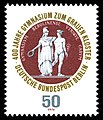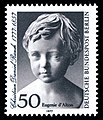Category:Classicism on stamps
The art of the Classicism in Europe is the art of the most masterworks created in the years ca. 1740s-1840/50s. One is speaking (with fluent transitions) from:
a) Early Classic: for the time around 1740-1760, inclusively
- - "Louis seize" and "style transition" in France
- - "Late Georgian" in Great Britain
- - the beginnings of the "Prussian Classic" in Germany
b) High Classic: for the time 1760 to the French Revolution
c) Late Classic for the time parallel and after the Napoleonic era in Europe:
- - "Revolution style" in France to the end of the Napoleonic era
- - "Restauration style" after the Napoleonic era
- - "Empire" on the British islands, inclusively "Adamstyle", "Palladianism", ...etc.
- - "Biedermeier" in Germany, Austria, Switzerland
- - "Wiener Klassik" in Austria, "Russian Classic" in Russia, "Portuguese Classic", ...etc.
Predecessor art style: Rococo (Late Baroque)
Successor art style(s): Romanticism, art styles of the Historism (among others with the "Neoclassicism"), art of the Enlightenment, Eclecticism, beginnings of the Impressionism ...etc.
Parallel art style(s): Genre painting
A classicistic art style is characterized in the early phase by a reversion to the characteristica of the Early Renaissance and their Roman and Greek paragons under general turndown from the allegorical interpretations of the Baroque. The color composition get increasingly unimportant and takes a backseat. A transistion from one color to an other is sharper demarcated. Nevertheless of all motion have all gestures a certain measure of silence. The style combines symmetry, harmony and professionalism, and in association with that also a certain rational sobriety and severity.
Subcategories
This category has the following 9 subcategories, out of 9 total.
Media in category "Classicism on stamps"
The following 45 files are in this category, out of 45 total.
-
1950 CPA 1589.jpg 439 × 311; 23 KB
-
1950 CPA 1590.jpg 439 × 313; 21 KB
-
1957 University of Calcutta 10 NP.jpg 896 × 794; 535 KB
-
1973 CPA 4231 mint.jpg 900 × 1,245; 203 KB
-
1980 CPA 5105.jpg 893 × 1,247; 222 KB
-
1982 CPA 5279.jpg 1,921 × 2,646; 4.96 MB
-
1984 CPA 5483.jpg 1,879 × 2,599; 3.98 MB
-
1984 CPA 5573.jpg 1,893 × 2,602; 4.17 MB
-
DBPB 1962 228 Opernhaus.jpg 840 × 720; 553 KB
-
FIN 1963 MiNr0577 pm B002.jpg 593 × 424; 134 KB
-
Helsinki-University-1940.jpg 380 × 275; 55 KB
-
Jean Auguste Dominique Ingres.jpg 400 × 561; 91 KB
-
NIC 1989 MiNr2968 pm B002.jpg 1,426 × 908; 539 KB
-
NIC 1989 MiNr2969 pm B002.jpg 1,370 × 1,110; 669 KB
-
NIC 1989 MiNr2973 pm B002.jpg 1,346 × 1,092; 702 KB
-
NIC 1989 MiNr2974 pm B002.jpg 1,139 × 1,417; 655 KB
-
Riga 1950 60kop USSR.jpg 453 × 322; 109 KB
-
ROM 1957 MiNr1669 mt B002.jpg 1,146 × 1,461; 604 KB
-
Saar 1952 340 Georg Melchior Kraus - Knabenbildnis.jpg 670 × 1,000; 700 KB
-
SBZ Thüringen 1946 111A X Deutsches Nationaltheater Weimar.jpg 840 × 700; 380 KB
-
SBZ Thüringen 1946 Bl.3A X Wiederaufbau.jpg 2,570 × 2,570; 4.05 MB
-
Stamp 1941 DRBM MiNr0079 mt B002a.jpg 2,248 × 1,165; 1,015 KB
-
Stamp 1941 DRBM MiNr0080 mt B002a.jpg 2,110 × 1,090; 953 KB
-
Stamp 1941 DRBM MiNr0080 pm B002.jpg 2,140 × 1,260; 1,004 KB
-
Stamp 1948 Monaco MiNr0348 mt B002.jpg 1,509 × 975; 669 KB
-
Stamp 1969 UAE-RK MiNr0322A pm B002.jpg 1,327 × 2,169; 1.02 MB
-
Stamp of Germany (DDR) 1960 MiNr 797.JPG 2,112 × 1,248; 315 KB
-
Stamp of USSR 1503.jpg 1,885 × 1,408; 1.65 MB
-
Stamp of USSR 1510.jpg 2,098 × 1,550; 2.23 MB
-
Stamp of USSR 1534.jpg 1,814 × 1,271; 1.2 MB
-
Stamp of USSR 1605.jpg 2,044 × 1,368; 806 KB
-
Stamps of Germany (Berlin) 1972, MiNr 422.jpg 720 × 840; 434 KB
-
Stamps of Germany (Berlin) 1974, MiNr 472.jpg 720 × 840; 357 KB
-
Stamps of Germany (Berlin) 1977, MiNr 541.jpg 720 × 840; 470 KB
-
Stamps of Germany (BRD), Olympiade 1972, Ausgabe 1970, 20 Pf.jpg 1,120 × 700; 632 KB
-
Stamps of Germany (BRD), Olympiade 1972, Ausgabe 1970, 30 Pf.jpg 1,120 × 700; 650 KB
-
Stamps of Germany (BRD), Olympiade 1972, Ausgabe 1970, 50 Pf.jpg 1,120 × 700; 645 KB
-
StampTartu(Estonia)1941Michel8.jpg 358 × 421; 165 KB
-
VAE-FU 1972 MiNr0847A pm B002.jpg 1,056 × 1,517; 785 KB
-
VAE-FU MiNr0846A pm B002.jpg 1,090 × 1,561; 911 KB
-
Почтовая марка СССР № 5185. 1981. Отечественная живопись.jpg 369 × 510; 107 KB
-
Почтовая марка СССР № 5279. 1982. Русская живопись.jpg 460 × 635; 109 KB












































